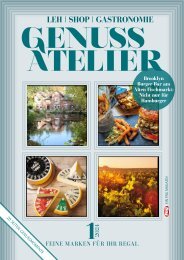food Marketing - Technology 2/2024
food Marketing & Technology is the international magazine for executives and specialists in the food industry.
food Marketing & Technology is the international magazine for executives and specialists in the food industry.
You also want an ePaper? Increase the reach of your titles
YUMPU automatically turns print PDFs into web optimized ePapers that Google loves.
Ingredients<br />
and texture. For analysing and comparing<br />
the boiled sausages there are<br />
different methods in use.<br />
Nutritional values<br />
First the nutritional value of the sausages<br />
is measured by the Food GmbH<br />
Jena Analytic-Consulting:<br />
• fat content according to<br />
method ASU §64 LFGB L<br />
06.00-6<br />
• fibre content according to<br />
method ASU §64 LFGB<br />
L 00.00-18<br />
• calorific value calculated<br />
according to Art. 31 Abs.<br />
1 EU regulation No. 1169/2011<br />
The results in table 1 show that the<br />
aim is reached by decreasing the fat<br />
content down to 10 % and increasing<br />
the fibre content up to 3 %. By replacing<br />
the fat, the whole calorific value<br />
is decreasing.<br />
Sensorial test & texture analysis<br />
Secondly the sensorial test “sensory<br />
preference test”, which is focussing<br />
on the evaluation of the consumers,<br />
has been performed. The consumers<br />
received the two different sausages<br />
marked with a code for a blind test.<br />
Afterwards the products were scored<br />
from 1 to 5 while 1 means “very good“<br />
and 5 “very bad“. At strong deviations<br />
a comment was added. Requirement<br />
for the blind test were healthy conditions<br />
of the test panel, since an infection<br />
could always have impacts on<br />
the sensory system of the test consumers.<br />
Figure 1 shows the results after 21<br />
consumers have tested the sausages<br />
and evaluated the texture, the taste,<br />
the odor and the look of the products.<br />
Odor and look are almost the same for<br />
both products - for the odor the result<br />
is at average 2,3 and for the appearance<br />
at 2,2. The taste of the Standard<br />
and V1 is nearly the same, at average<br />
2,25 and V1 has a taste with 2,28.<br />
The texture has been the attribute<br />
with a slight difference between the<br />
sausages. The Standard is at average<br />
2,1, V1 is a little higher.<br />
Hence the third test performed has<br />
been the texture analysis by using<br />
the TexturePro CT V1.8 Build 31<br />
from Brookfield. The bite becomes<br />
imitated by running the measuring<br />
body into the sausage with constant<br />
speed. When the sausage is breaking<br />
apart, the graph is showing a<br />
peak. The higher the peak, the more<br />
weight the TexturePro needs to break<br />
through. Figure 2 shows the results of<br />
the break through to imitate the bite.<br />
For the standard sausage up to 550 g of<br />
weight are necessary, for V1 a bit more<br />
than 550 g and for V2 around 525 g.<br />
Trial evaluation & conclusion<br />
The results of the analytical tests are<br />
displaying that the goal is reached, a<br />
healthy boiled sausage with a reduced<br />
fat content down to 10 % and an<br />
increased fibre content up to 3 % is<br />
accepted by consumers. This aim is<br />
easy to achieve by using SANACEL®<br />
add 035 instead of neck fat.<br />
Therefore SANACEL® add 035 is a<br />
perfect solution for the replacement<br />
of fat in sausages without losing the<br />
attributes that make the product delicious.<br />
Even the consumers who tested<br />
the boiled sausages during the<br />
sensory test could not find a difference<br />
between the products. The only<br />
deviation they found was the texture.<br />
But even the texture analyser could<br />
just measure small differences between<br />
the standard sausage and the<br />
V1- sausage with SANACEL® add 035.<br />
With regard to a healthy diet and good<br />
weight management, the replacement<br />
of fat is also possible in bakery<br />
products. Trials have shown that fat<br />
reduction in muffins or sponge cakes<br />
can easily be achieved with dietary<br />
fibre. With a fat reduction of 30 % without<br />
fibres and additional water, the<br />
muffin loses its shape and airy, fluffy<br />
texture. Using the fibre mixture SAN-<br />
ACEL® add and water, the volume and<br />
moistness is retained. The gel-like fat<br />
substitutes of the SANACEL® add fib-<br />
16 <strong>food</strong> <strong>Marketing</strong> & <strong>Technology</strong> • April <strong>2024</strong>

















